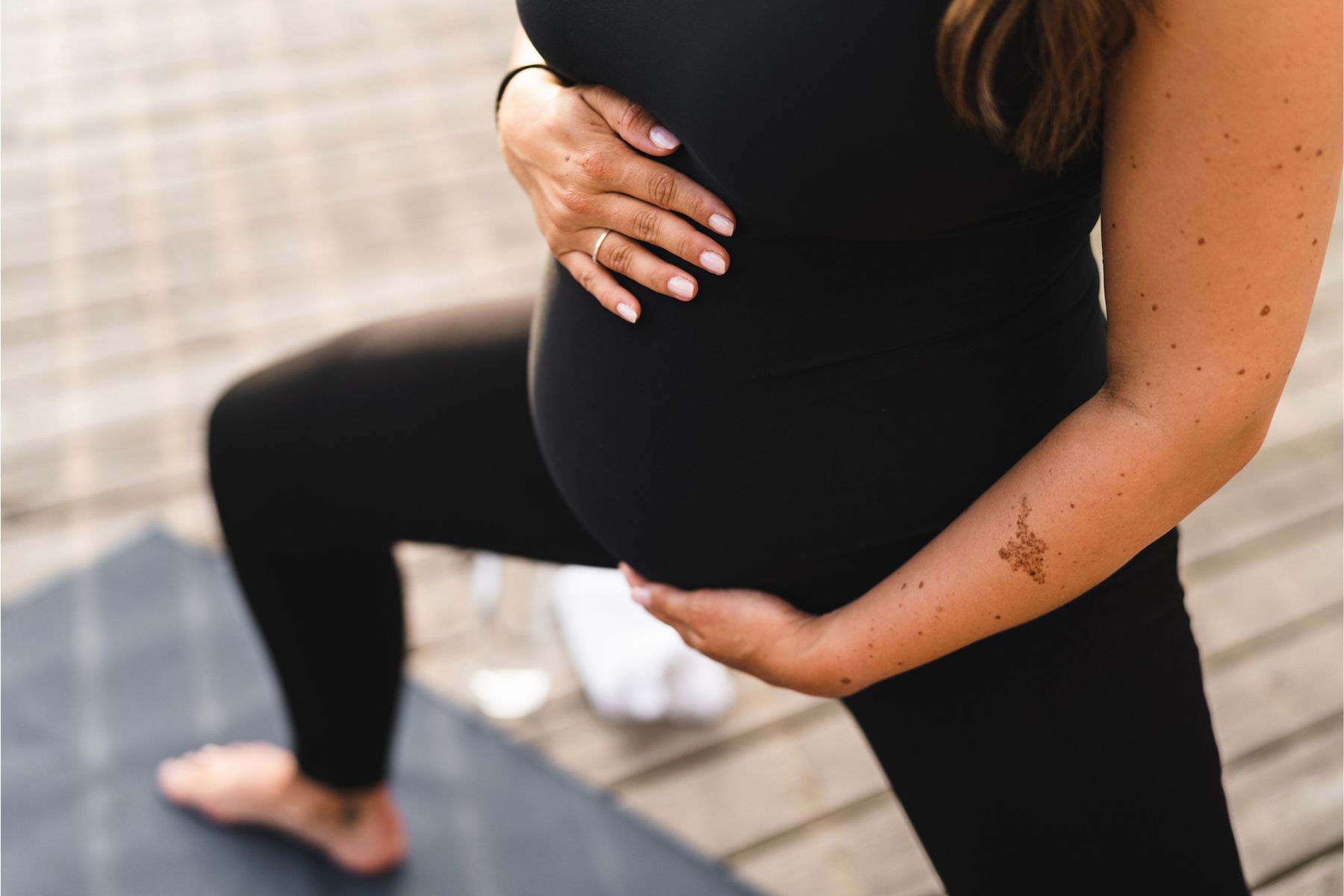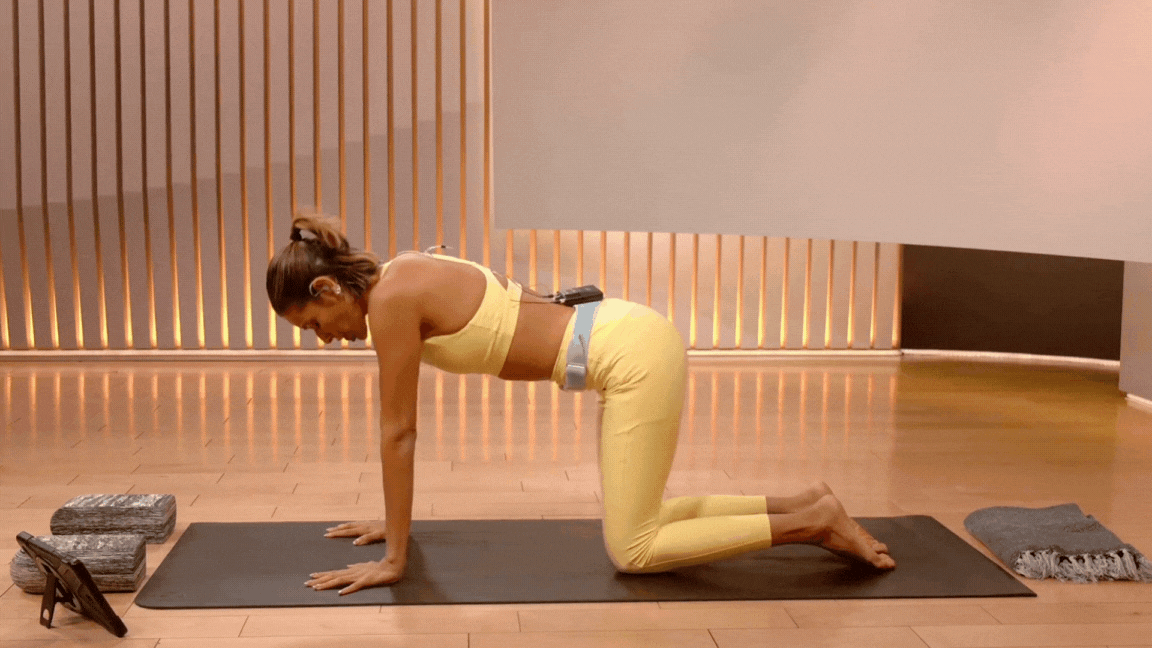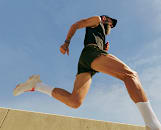
luza studios/ E+ via Getty Images
Everything You Need to Know About Practicing Yoga During Pregnancy
Connect with your body and your baby—and get some pain relief in the process.
By Colleen Travers, Michele Ross•
What Is Prenatal Yoga?
What Are the Benefits of Prenatal Yoga?
Prenatal Yoga by Trimester
10 Prenatal Yoga Poses
Safety Precautions to Take for Yoga During Pregnancy
Yoga Poses to Avoid During Pregnancy
How to Start a Prenatal Yoga Practice
What to Expect from a Pregnancy Yoga Class
Growing a human is hard work. Not only are you finding a new equilibrium (literally, as your body evolves to carrying around a watermelon), you’re also dealing with a shift of hormones that cause symptoms like fatigue, headaches, and nausea, plus other undesired side effects such as back and hip pain. Thankfully, prenatal yoga can help.
Discover more ways to reach your goals with Peloton
Exercise is beneficial for a healthy pregnancy, according to The American College of Obstetricians and Gynecologists. And even though it may be safe to continue what you were doing before you became pregnant—such as running, rowing, or riding the Peloton Bike—you may be looking for a low-impact way to exercise and reduce uncomfortable pregnancy symptoms. Enter: prenatal yoga, a type of yoga that helps you connect with yourself and your baby during pregnancy—not to mention feel better in the process too.
Whether you’re new to yoga or a longtime practitioner, there’s a prenatal yoga practice for everyone. Here’s what you need to know about prenatal yoga, including how to get started and how to practice safely.
What Is Prenatal Yoga?
Prenatal yoga is a yoga practice designed to increase strength and flexibility in pregnant people, says Peloton yoga instructor Anna Greenberg. By focusing on gentle stretches and postures, you’ll not only work your joints and muscles but also learn how to focus on your breathing.
Prenatal yoga differs from a traditional practice as prenatal yoga poses are modified to be more comfortable for those expecting. There may also be more use of props in class, such as towels, a bolster, and yoga blocks for added comfort.

Peloton App
Access thousands of classes with no equipment needed.
What Are the Benefits of Prenatal Yoga?
Prenatal yoga offers a range of mind-body benefits to support you throughout your journey. “As the body changes during pregnancy, the brain must adjust to maintain balance—especially as the growing belly shifts the center of mass, and hormone fluctuations affect mobility,” says Kate Besong, PT, DPT, a pelvic floor physical therapist with Mims Method Physical Therapy in New York City. “Practicing yoga before, during, and after pregnancy helps the body adapt by supporting mobility, alignment, and strength so that your brain knows how to best control your changing body.”
According to a 2022 research review in the journal BMC Pregnancy and Childbirth, prenatal yoga can seriously sharpen your mental health during the roller coaster ride of pregnancy by helping to reduce anxiety, depression, and perceived stress. “Practicing [prenatal] yoga helps to create a calm, steady mental state and teaches you tools you can draw on to bring you back to that place of calm, strength, and openness in challenging moments,” Anna says. She adds that prenatal yoga allows you to feel empowered, connected, and embodied as your journey unfolds.
Prenatal yoga can also help relieve physical discomfort—both during the changing phases of pregnancy and during labor and delivery. Per the research review above, prenatal yoga may reduce the duration of labor, increase the odds of normal vaginal birth, and increase pain tolerance.
Prenatal Yoga by Trimester
There isn’t a one-size-fits all approach to prenatal yoga, because every body and every pregnancy is different, Anna says. “In general, as your belly grows, you will need to create more space and use more support,” she says.
Here’s what you can expect from your practice as you move through your pregnancy trimesters.
First Trimester Prenatal Yoga
No matter where you are in your yoga journey, you may not notice much of a difference in your yoga practice during the first trimester of pregnancy. Any differences you feel will primarily result from the side effects of pregnancy.
“You may still be able to do much of what you were doing previously to being pregnant, but you may also experience extreme fatigue and nausea,” says Anna. “It’s important to acknowledge how much your body is doing even when it’s not visible, and practice in a way that is supportive and compassionate.”
Give yourself grace as you mentally and physically adjust to pregnancy. Exercise like prenatal yoga can certainly help symptoms, but there may be days when you can’t muster the strength to roll out the mat—and that’s OK too.
Second Trimester Prenatal Yoga
The second trimester is the sweet spot of pregnancy. Hopefully, those uncomfortable first trimester symptoms subside, leaving you with newfound energy and less nausea.
“This can be a time to embrace movement to feel strong if you are feeling good,” says Anna. If you’re new to yoga and hope to start a prenatal yoga routine, the second trimester is a good place to start, as you’ll likely be feeling better and have more energy to stick to a routine. Since your stomach is growing, this is also a good time to stop doing poses that involve lying on your stomach, such as Superman or Bow Pose.
“Starting at 20 weeks, you will want to avoid lying flat on your back for an extended period of time due to the pressure on the vena cava,” says Anna. “You can take Savasana (Corpse Pose) on an incline with a bolster [a firm and supportive tube-shaped pillow] and two yoga blocks, or in Left-Side Lying Position.”
If you’re using a bolster and yoga blocks, you’ll make an “L” with the yoga blocks near the top of your mat: One yoga block will be horizontal and flat on the lowest height, the other vertical on the highest height. Next, place the bolster on the mat over the yoga blocks so that you’ve created a pillow for your head with bolster support going down your back too.
Third Trimester Prenatal Yoga
The finish line is in sight—but potentially so is the return of some of the unpleasant pregnancy symptoms you felt in the first trimester. “You may feel a little uncomfortable and fatigued,” Anna notes.
But good news: A yoga practice can help with that. “Yoga can still feel great, and often help relieve symptoms,” Anna says. “You may be feeling your baby much more at this point. It can be a wonderful time to really connect with your little one and move as a team as you practice. Listen to your body, and go at your own pace.”
Remember that your balance will be off in your third trimester, so you may have to modify poses more during this stage of pregnancy. “This is a time where we want what’s happening inside to take hold and grow, so hopping and jumping around or practicing arm balances and inversions where falls may happen is something many practitioners will want to avoid,” says Anna.
If you feel comfortable enough to do yoga, even for just 10 minutes a day, it’s worth it. Yoga can help decrease feelings of stress, depression, and anxiety, in addition to relieving pain or discomfort that comes in those last weeks of pregnancy.
10 Prenatal Yoga Poses

1. Cat-Cow Pose
Both Anna and Besong cite Cat-Cow Pose as one of the best prenatal yoga poses.
Get into starting position on all fours. Gently exhale and activate the core to “hug” the baby towards your spine to support your lower back. (You could also do a pelvic floor contraction at the same time.)
Lift your spine to the ceiling and pull your navel inward while lowering your head like an angry cat to open your upper back.
Gently inhale and relax the core with control as you drop your spine into a gentle arch like a happy cow. Draw your shoulder blades together to open your chest.
If you need to modify this pose, Besong suggests keeping your hands elevated on a low surface or placing a soft yoga blanket under your knees for comfort.

2. Hip Circles
Though not technically a yoga pose, seated hip circles get the green light from Anna to gently mobilize the hips.
Start in Hero Pose with your shins on the mat and your knees together or closed. Keep your feet open to the sides and move into an all fours position. You can also place your hands on top of blocks.
Gently rock from side to side and/or shift forward and back, making sure to perform equal movements in each direction.
“As pregnancy progresses, the body is naturally forced more into external rotation,” says Anna. However, she emphasizes the importance for pregnant people to get more internal rotation into their prenatal movement routine. “This position helps to open the outlet of the pelvis, and shapes like this are a great, relieving counter stretch,” she continues.

3. Warrior 1 (Virabhadrasana 1)
Warrior 1 Pose isn’t just a foundational yoga posture; it’s also approved for prenatal yoga. While pregnant, Anna advises widening your stance horizontally as needed.
Stand tall at the top of your mat with your feet hip-width distance apart.
Step your left leg back. Rotate your left toes to point toward the top left corner of your mat, aiming to keep your left and right heels aligned.
Keep your hips square to the front of the mat. Evenly distribute your weight between your legs.
Bend your right knee to a 90-degree angle (or as close to it as is accessible), keeping your knee directly over your ankle.
On an inhale, lift your arms straight overhead with your palms facing one another. Drop your shoulders away from your ears and engage your core. Keep your gaze, hips, and torso facing forward.
Hold for three to five slow breaths.
Place your hands down on the mat. Switch your legs to repeat Warrior 1 on the other side.

4. Warrior 2 (Virabhadrasana II)
Another staple in countless yoga sequences, Warrior 2 Pose is also safe for pregnancy. In this pose, Anna suggests keeping your stance a little less wide than usual. Anna shares that if someone is experiencing symphysis pubis dysfunction (SPD), a common condition that causes uncomfortable movement in the pelvic joints, “they can shorten the stance even more.” In either case, she cautions against over stretching since there’s more of the hormone relaxin in the body during pregnancy. (More on this hormone later.)
Stand tall at the top of your mat with your feet hip-width distance apart.
Step your left leg back. Rotate your left toes to point toward the top left corner of your mat, aiming to keep your left and right heels aligned.
Keep your hips square to the front of the mat. Evenly distribute your weight between your legs.
Bend your right knee to a 90-degree angle (or as close to it as is accessible), keeping your knee directly over your ankle.
Extend your arms outward from your shoulders. Now, turn your head to look forward over your right fingers.
Hold this pose for a few deep breaths, then straighten your right knee to return to a standing position. Repeat on the other side.

5. Wide Leg Standing Forward Fold (Prasarita Padottanasana)
In this standing forward fold, Anna suggests supporting your hands with blocks. “This is a great one to add a side stretch by walking your hands to each side, and you can turn the toes inwards to get an internal rotation in here, too,” she says.
Stand sideways on your mat with your feet about three to four feet apart. Keep your feet parallel with your toes pointing in slightly.
Place your hands on your hips, inhale, and lengthen your spine.
On an exhale, hinge at your hips and fold forward.
Bring your hands to the floor (or to blocks) under your shoulders.
Relax your neck and let your head hang long.
Stay for five breaths, then slowly rise back up with a flat back.

6. Goddess Pose (Utkata Konasana)
Besong suggests doing Goddess Pose to strengthen your lower body and open your hips.
Stand with your feet three to four feet apart with your toes pointed outward and trunk tall, then lower down into a comfortable squat, keeping your knees in line with your toes. Keep your hands at heart’s center, or place them on your hips or a chair for support.
Gently inhale while relaxing and lengthening the pelvic floor.
Exhale while lifting the pelvic floor muscles to support the uterus.
To modify this pose, Besong advises doing shorter holds and/or supporting your hands on a chair.

7. Dynamic Yoga Squats
Dynamic yoga squats will help you stretch and build stamina, says Anna. “These are in external rotation which helps to open up the inlet of the pelvis, which helps the baby descend into the pelvis during labor.”
Stand with your feet wide and slightly turning out. Hold your arms at your sides.
Imagine pressing the mat apart between your feet as you bend your knees and lower down to a squat, ensuring that your knees track over the toes. Lift your arms overhead as you squat down.
Straighten your legs to stand and lower your arms in time with your breathing, then repeat the movement.

8. Tree Pose (Vrksasana)
Besong lists this standing balancing pose as one of her top recommendations in a prenatal yoga routine.
Stand with your weight shifted onto one foot. Avoid locking the knee. Keep your eyes focused forward on an unmoving spot to help with balance.
Place your other foot onto the inside of your ankle, shin, or the inside of the thigh above the knee. Place your hands at heart’s center or on your hips or a chair for support.
Hold for a few breath cycles while focusing on finding the center of gravity in your changing body.
Gently release your foot to the floor and switch sides.
Having an off day or getting used to balancing as your body grows? “Modify this pose by keeping the toes on the ground for support,” Besong advises.

9. Supine Bound Angle Pose (Supta Baddha Konasana)
This restorative yoga pose is one of Anna’s all-time favorites. To make it more pregnancy-friendly and relaxing, she suggests using yoga props including bolsters, blocks, and blankets.
Place one block on the lowest height on your mat and the second block on the highest height directly behind the first. The two blocks should touch and create an “L” shape. Place your bolster over the blocks to create a ramp.
Fold one yoga blanket and place it at the top of the bolster as a cushion for your head. Make a long, skinny roll with a second blanket.
Sit with the back of your pelvis against the bolster. Place your feet on the mat with your knees bent. Place the rolled blanket across the front of your ankles and tuck either end beneath your legs and up toward the sides of your hips.
Lay down onto the bolster and open your knees out wide. Adjust the ends of the rolled blanket to support your outer hips, thighs, and legs.
Keep your arms open wide to the sides. Hold the pose for up to a minute or as long as it feels comfortable.
Anna advises placing your knees together with your feet wide along the side edges of your mat if external rotation isn’t feeling good, there’s symphysis pubis dysfunction, a breech baby, or placenta previa (where the placenta attaches low in the uterus). “The externally rotated squat-like position could encourage the baby to drop further into position, so we avoid those shapes for these cases and stick to more neutral or internally rotated legs,” she shares. In addition, she says it’s best to limit this pose to earlier in your pregnancy.

10. Left-Side Lying Savasana
This take on traditional Savasana is ideal for the third trimester, says Anna. But it feels so good, you may want to add it to your regular practice.
Lay on one side with a blanket under your head and a bolster between your knees, legs, and feet.
Let your bottom arm relax under your head or in front of you, while your top arm rests on the bolster.
Relax and breathe deeply before switching sides.
Want to maximize the bliss in this calming, restorative prenatal yoga pose? “Elevate the bottom end of the bolster on a block to bring the top leg into a more internally rotated position,” Anna shares.
Safety Precautions to Take for Yoga During Pregnancy
Whether or not you have an established yoga practice pre-pregnancy, make sure to get the green light from your doctor before doing any physical activity—including prenatal yoga.
When you’re pregnant, your body produces more relaxin, a hormone responsible for loosening muscles, joints, and ligaments. Of course, this is a good thing as you’ll need that elasticity later, but you should be mindful of it when doing yoga during pregnancy. “While you want to be supple and open during pregnancy, it’s not the time to go for maximum stretch,” says Anna. That said, one of her favorite pregnancy mantras is “Optimum, not maximum.”
She also cautions that balance becomes more challenging the further you get into your pregnancy. “Taking as much support as needed is key,” she says—especially for poses that require more balance, such as Tree Pose.
Last but not least, Besong says it’s safe to lay on your back for short durations during prenatal yoga so long as your body welcomes it. “However, most people find it less comfortable by the second trimester,” she shares.
Yoga Poses to Avoid During Pregnancy
According to Besong, most yoga poses can be modified in some way to accommodate pregnancy. However, she advises against:
Deep twists that compresses the abdomen
Deep backbends that risk overstretching
Inversions (including Headstand and arm balances) that can cause loss of balance
Intense core activation (such as crunches or Boat Pose) that can strain abdominal muscles
Long holds (such as those in yin yoga) that can affect blood pressure and circulation
In addition, Anna cites hopping and jumping—including but not limited to hopping to the front of your mat during Sun Salutations and jumping back into Chaturanga—as no-gos.
If you enjoy these types of poses or crave the stretch they provide, you can modify some within reason (depending on how far along you are and what your doctor approves). For example, “You can still stretch your chest and back using support [like a yoga block], and you can still twist, focusing the turn above the bra line, keeping your belly nice and neutral,” says Anna. “With the proper modifications and support, there is so much you can do.”
In addition, hot yoga and Bikram are generally not recommended for the safety of mother and baby alike. There are no published studies on the safety of hot yoga during pregnancy, but the main concern centers around hyperthermia (abnormally high body temperature). Being exposed to such high temperatures may have adverse effects for you and your baby as they develop. (If you frequently practice hot yoga and can handle the heat, your doctor may be comfortable with you sticking to your practice. Discuss this with them before you keep going so they can provide you with the best recommendations for you.)
How to Start a Prenatal Yoga Practice
One of the best things about yoga is that you don’t need much to get started. In your first trimester, all you’ll need is a mat and some comfortable yoga clothing. As you move past your first trimester, it’s a good idea to invest in a set of yoga blocks and bolster for support—especially for some of the approved prenatal yoga poses shared above. A yoga strap can also help with stretching if you have limited flexibility.
When it comes to how often you should practice prenatal yoga, “a couple times a week is a great place to start, but if you felt like doing more, or just once a week, that would be fine too,” says Anna. “Start with beginner prenatal yoga classes. After getting familiar with some of the basic shapes and modifications, my trimester-focused Prenatal & Postnatal Yoga & Meditation Collection is tailor-made to this time, and [all levels] are welcome.”
What to Expect from a Pregnancy Yoga Class
Whether you’re taking a prenatal yoga class in-person or online, all prenatal yoga practices follow a similar format.
Depending on the length of the class, you’ll do a warm up that’s between two to five minutes. This will include stretches and moves like hip circles, Child’s Pose, Downward Dog, arm stretches, and other exercises to make it easier to hold poses. Your instructor will tell you what (if any) props you need, as well as helpful pointers for the class ahead.
Then, you’ll move into the meat of the class. Prenatal yoga is heavily based in holding specific stretches, versus poses or flows for a long period of time. Some classes focus on specific body parts, such as hips and lower body, while others are more of a full-body flow. The class will end with Savasana to still your mind and body. Remember: You’ll want to use your bolster and yoga blocks to support your lower body during Savasana in the second trimester and switch to lying on your left side in the third trimester.
“Practicing prenatal yoga is a wonderful way to connect to yourself and your baby during pregnancy,” says Anna. Listen to your body and heed your doctor’s orders to experience a safe and well-rounded prenatal yoga routine that will help you prepare for the wonderful journey ahead.
This content is for informational and educational purposes only and does not constitute individualized advice. It is not intended to replace professional medical evaluation, diagnosis, or treatment. Seek the advice of your physician for questions you may have regarding your health or a medical condition. If you are having a medical emergency, call your physician or 911 immediately.
Level up your inbox.
Subscribe for a weekly dose of fitness, plus the latest promos, launches, and events.
By providing your email address, you agree to receive marketing communications from Peloton.
For more about how we use your information, see our Privacy Policy.












